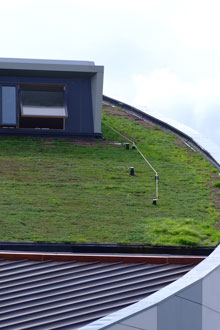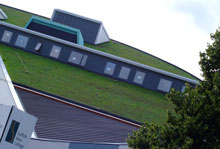The FM Challenges of Maintaining a Low Carbon Development
Tony Russell, Deputy Director of Estates at University Campus Suffolk (UCS) in Ipswich knows all too well about the challenges of making a green building work.
An iconic landmark in Ipswich, the £31m UCS Waterfront Building, completed in 2008, is crowned with a 1,400sq metre sloping Bauder sedum roof and a host of other sustainable features which achieved a BREAAM 'excellent' rating.
What keeps you awake at night?
"In short - budgets, security and compliance. Like many others, my revenue budget is set 12 months in advance, but I have to apply for capital budget as and when. The main campus building is operational 24/7 so first-rate security is essential. Although some of the buildings I manage are new builds, others are older and require different levels of maintenance, mostly for things people can't see, such as heating and ventilation."
Is your job made more straightforward by having low carbon buildings?
"In the new buildings, which both have ‘excellent’ BREEAM ratings, I have a centrally controlled CAFM system, so I can check various things from my PC, including the temperature of each area and where security has patrolled (by tracking their pass cards through doors).

I don't think the newer buildings are easier, just different challenges, there's still regulations to adhere to, for example, workplace law and statutory testing . When it does become more of an issue, is during refurbishment, particularly around practicality and litigiousness."
How much of a difference do you think the green credentials make to your buildings?
"The jury is still out on the energy savings we’ve achieved at UCS, we need another two years' of bills to work out the savings. However, the green roof is certainly a talking point, as indeed the whole building is. The green roof is instantly recognisable and a little bit of green goes a long way. Much of the Waterfront building internally is bare concrete, which has its own environmental properties and this is a stark contrast to the green roof.
Rob Woolston, Bauder Area Technical Manager for the project, added: “The sedum used on the 20 degree sloping roof is a thick, fleshy, cactus-like plant which can withstand extreme hot and cold temperatures. It effectively doubles the life of the roofing membrane. Sedum is cultivated in long lengths of blanket, on a moisture retention fleece before being harvested, delivered to site and lowered into place. At UCS the sedum will attract small wildlife and help reduce rainwater run-off through absorption.”
How seriously does your employer take sustainability?
“University Campus Suffolk, as a large and complex organisation, seeks to give sustainability a high priority. We have a Sustainability Strategy – ‘The 4Cs’, which provides a clear structure around Curriculum, Campus, Community and Culture. We aim to reduce our carbon usage by 30% by 2030 and we monitor several aspects of our operations including: energy, waste, water, purchasing, development, transport and regulations.”

ESSENTIAL STATISTICS
GREEN ROOF: The large, angled sedum roof is planted with up to 25 different varieties of succulents, moss and grasses. It provides excellent insulation and ameliorates the impact of storm water loads on local drainage systems, whilst actively encouraging biodiversity on what was once a bleak brownfield site.
INSULATION AND GLAZING: High levels of wall and roof insulation enclose a high thermal mass structure. The structural concrete is designed to act as a thermal battery wrapped in the building's blanket of insulation, storing or absorbing heat as required. The high performance glazing design and specification reduces solar gain.
HEAT WHEEL VENTILATION: There is no air conditioning in the UCS building. Extensive heat recovery systems use fresh air circulation, including a heat wheel. High efficiency heating and ventilation systems are controlled by computer and designed to respond quickly to the building's level of occupation
WATER SAVING: Water-saving systems and low-energy hand dryers are installed in washrooms.
CLIMATE ADAPTATION: There is a flood mitigation system, recognising future contingencies. No electrical systems are within 900mm of ground level, and walls and floors designed to withstand flood damage.
CYCLE FACILITIES: Extensive bicycle parking, with showers and changing facilities, encourage sustainable travel.
BUILDING MANAGEMENT SYSTEM: An advanced building management system controls variable-speed ventilation and heating systems.
LIGHTING: There is no incandescent lighting (except in the lifts!). Lighting is controlled by occupancy sensors in many areas.